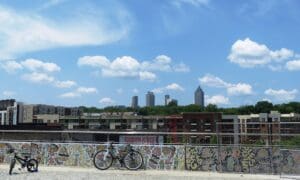A glimpse at the largest development in Fayetteville since the official unveiling of Pinewood Forest will have to wait until late April. The large Folia Crossroads residential and commercial proposal on the city’s west side was tabled at the March 27 meeting of the Fayetteville Planning and Zoning Commission while the proposal completes the DRI (development of regional impact) process.
Above, Fayetteville Planning and Zoning Commission. Photo/Ben Nelms.
Representatives for the Folia Crossroads development asked, and commissioners agreed, that the item be tabled. The official proposal will return once the development has been reviewed through the DRI process by the Atlanta Regional Commission and the Georgia Regional Transportation Authority.
As initially proposed as a non-voting work session item in February, the mixed-use development along Ga. Highway 54 West and South Sandy Creek Road and bordering Lake Bennett, is proposing 260 detached homes, 100,000 sq. ft. of retail and 50,000 sq. ft. of office space.
Folia Crossroads is expected to be on the April 24 agenda.
As initially presented as a February work session topic, the retail and office component of the 153-acre property would be located along Hwy. 54 and would include restaurants, a brewery, commercial space, retail space, a drug store, hotel and theater. There is a potential for a number of loft apartments over the retail, according to submitted plans.
The residential component would be situated on the north and west portions of the property and would include 260 detached homes. Homes would range from 1,500 sq. ft. to more than 4,000 sq. ft., with price points from the $300,000s to the low $400,000s.
The residential area would also include a 3-5-acre urban farm.
The development was touted as being a combination of New Urbanist and New Ruralism.
Developers said the walkable and connected development would include 58 percent greenspace.
The Williams property was part of 1,200 acres annexed into the city August 2013. The properties prior to the annexation were slated to develop as hamlets with a mixture of residential and commercial.













Leave a Comment
You must be logged in to post a comment.